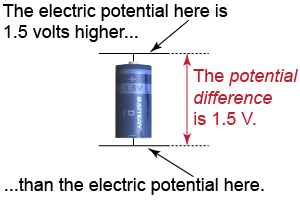|
Stray electric fields create interference with many electronic devices, which can be addressed through shielding. Although you might think that electric fields and electronic devices are always best kept apart, you would be wrong! Electric fields inside conducting wires are what causes currents to flow. Furthermore, electric fields are used for a key component found on most circuit boards: the capacitor. Capacitors are used to store charge and electrical energy. In this section, you will learn more about electric fields and how two charged, parallel plates are used to create a capacitor. 
|
Electric potential
|
 In Chapter 17 on page 489, you learned that any resistor connected across the terminals of a battery has the same voltage drop. An alternate way to describe this is that the positive terminal of the battery is at a high electric potential, and the negative end of the battery is at a low electric potential. The voltage across a battery—the difference between its two terminals—is also called the potential difference. In some textbooks you will find the “voltage” across a resistor, say, referred to as the “potential difference” across the resistor. The potential difference is simply the difference in electric potential from one side of the device to the other!
In Chapter 17 on page 489, you learned that any resistor connected across the terminals of a battery has the same voltage drop. An alternate way to describe this is that the positive terminal of the battery is at a high electric potential, and the negative end of the battery is at a low electric potential. The voltage across a battery—the difference between its two terminals—is also called the potential difference. In some textbooks you will find the “voltage” across a resistor, say, referred to as the “potential difference” across the resistor. The potential difference is simply the difference in electric potential from one side of the device to the other! 
|
While this is a useful description of electric potential for electric circuits, for electric fields it is more useful to define electric potential as the potential energy per unit charge, as in equation (18.4). Electric potential has units of joules per coulomb—although it can also be expressed in units of volts. 
|
| (18.4) | | | V | = | electric potential (V or J/C) | | Ep | = | electric potential energy (J) | | q | = | electric charge (C) |
| Electric potential
|
|
You can define the zero or reference electric potential at any location you want, just as you did for gravitational potential energy! The reference potential ought to be chosen in a way that is most simple or convenient. For electric circuits, the reference potential is usually chosen at the battery’s negative terminal or at ground (which are often the same). 
 |
For electric fields and electric potential energy, the reference potential is usually chosen at infinite distance. For the electric field around a point charge in equation (18.3), for example, the reference level is at infinite distance r, since E ∝ 1/r2. As r goes to infinity, E goes to zero. 
|
The electric potential for a point charge gets smaller the further away you are from the charge. The electric potential is also higher for higher electric charge. These relationships are part of equation (18.5), which describes the electric potential around a point source of charge q. 
|
| (18.5) | | | V | = | electric potential (V) | | ke | = | Coulomb constant = 9.0×109 N m2/C2 | | q | = | electric charge (C) | | r | = | distance between the two objects (m) |
| Electric potential
for a point source |
|
Inspection of equation (18.5) shows that the electric potential can be positive near a positive charge q while it can be negative near a negative charge. (It is zero, of course, at its reference point.) This should not be surprising, since the electric (Coulomb) force can be both positive and negative, depending on whether the charges have the same or opposite sign. 
|

